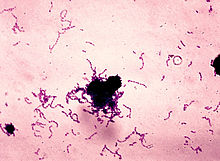
Back عقدية طافرة Arabic عقديه طافره ARZ Стрептококус мутанс Bulgarian Streptococcus mutans Catalan Streptococcus mutans Czech Streptococcus mutans German Streptococcus mutans Spanish Streptococcus mutans Basque استرپتوکوک موتانس Persian Streptococcus mutans French
| Streptococcus mutans | |
|---|---|

| |
| Stain of S. mutans in thioglycolate broth culture. | |
| Scientific classification | |
| Domain: | Bacteria |
| Phylum: | Bacillota |
| Class: | Bacilli |
| Order: | Lactobacillales |
| Family: | Streptococcaceae |
| Genus: | Streptococcus |
| Species: | S. mutans
|
| Binomial name | |
| Streptococcus mutans Clarke 1924
| |
Streptococcus mutans is a facultatively anaerobic, gram-positive coccus (round bacterium) commonly found in the human oral cavity and is a significant contributor to tooth decay.[1][2] The microbe was first described by James Kilian Clarke in 1924.[3]
This bacterium, along with the closely related species Streptococcus sobrinus, can cohabit the mouth: Both contribute to oral disease, and the expense of differentiating them in laboratory testing is often not clinically necessary. Therefore, for clinical purposes they are often considered together as a group, called the mutans streptococci.[4] This grouping of similar bacteria with similar tropism can also be seen in the viridans streptococci – which Streptococcus mutans is itself also a member of.[5]
- ^ Ryan KJ, Ray CG, eds. (2004). Sherris Medical Microbiology (4th ed.). McGraw Hill. ISBN 978-0-8385-8529-0.[page needed]
- ^ Loesche WJ (1996). "Ch. 99: Microbiology of Dental Decay and Periodontal Disease". In Baron S (ed.). Baron's Medical Microbiology (4th ed.). University of Texas Medical Branch. ISBN 978-0-9631172-1-2. PMID 21413316.
- ^ Thomas VJ, Rose FD (1924). "Ethnic differences in the experience of pain". Social Science & Medicine. 32 (9): 1063–6. doi:10.1016/0277-9536(91)90164-8. PMC 2047899. PMID 2047899.
- ^ Newcastle University Dental School. "Streptococcus mutans and the mutans streptococci. In: The Oral Environment, online tutorial". Archived from the original on 2013-11-05. Retrieved 2013-11-04.
- ^ English BK, Shenep JL (2009). "ENTEROCOCCAL AND VIRIDANS STREPTOCOCCAL INFECTIONS". Feigin and Cherry's Textbook of Pediatric Infectious Diseases. Elsevier. p. 1258–1288. doi:10.1016/b978-1-4160-4044-6.50100-x. ISBN 978-1-4160-4044-6.